Learn Irish Lace Making: Master the Art of Delicate Crochet Patterns
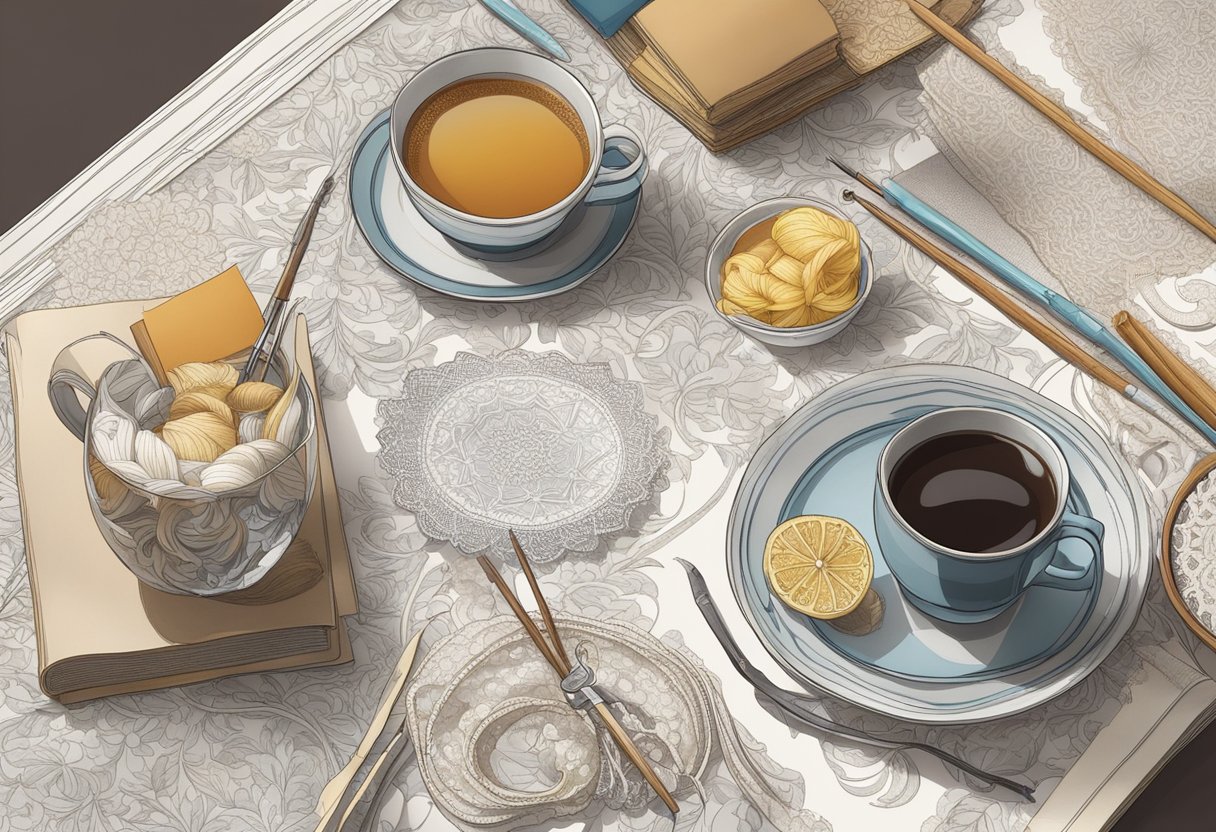
Updated On: April 22, 2024 by Ciaran Connolly
Irish lace-making is an art form steeped in history and cherished for its intricacy and elegance. Originating during the 19th century, Irish crochet lace evolved from traditional needlework practices and quickly became a symbol of skilled craftsmanship. The creation of Irish lace served as a vital source of income for many Irish people, especially during times of economic hardship. Today, it remains a captivating hobby for crafters and a luxurious detail in fashion design.
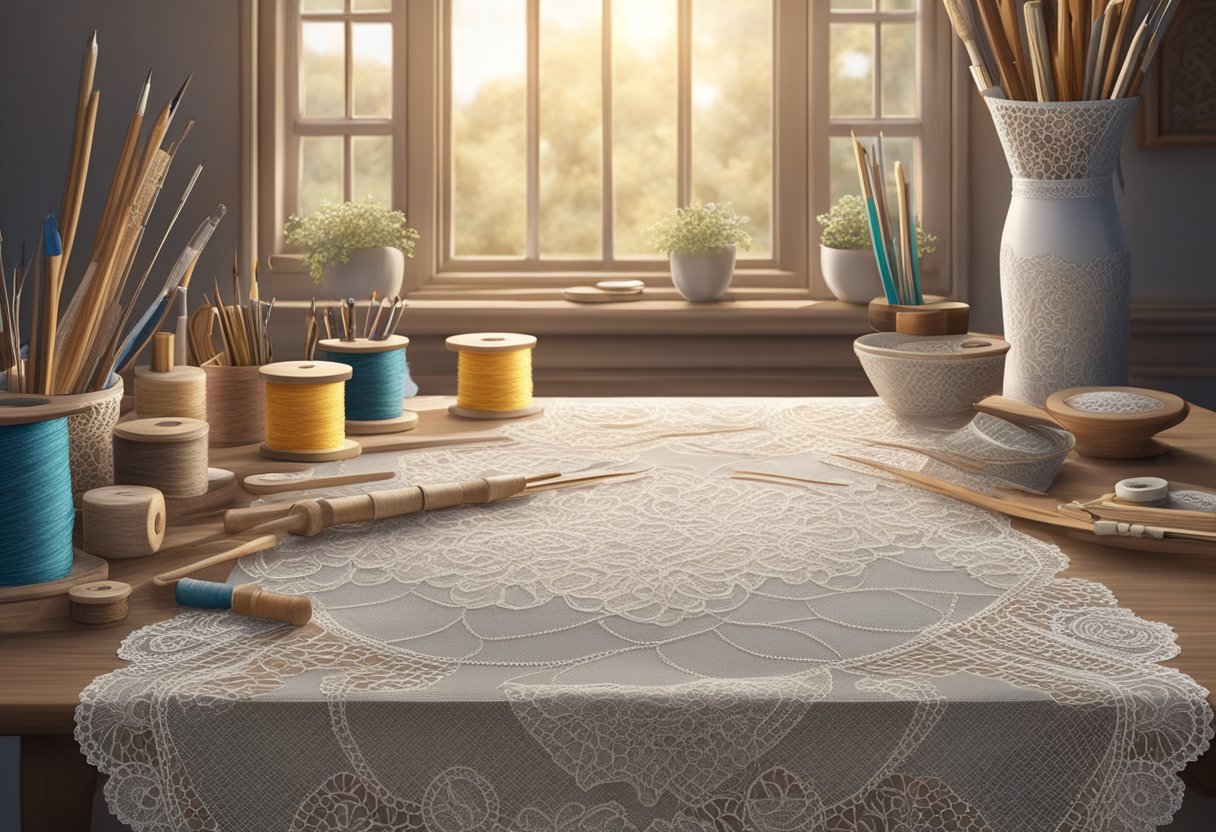
The fundamental appeal of Irish lace lies in its delicate and ornate patterns, which range from simple to complex, allowing for a breadth of design possibilities. Aspiring lacemakers can start by mastering the essential stitches and techniques with basic tools such as crochet hooks and fine cotton thread. Over time, one can learn to combine various motifs like flowers, leaves, and shamrocks, creating beautiful projects from doilies to wedding gowns. It’s not just a craft but a link to a rich cultural past and a form of creative expression.
Key Takeaways
- Irish lace-making carries a significant historical and cultural heritage.
- Beginners can learn with basic tools before progressing to intricate designs.
- Mastering Irish lace techniques allows for a wide range of creative applications.
The Origins of Irish Lace-Making
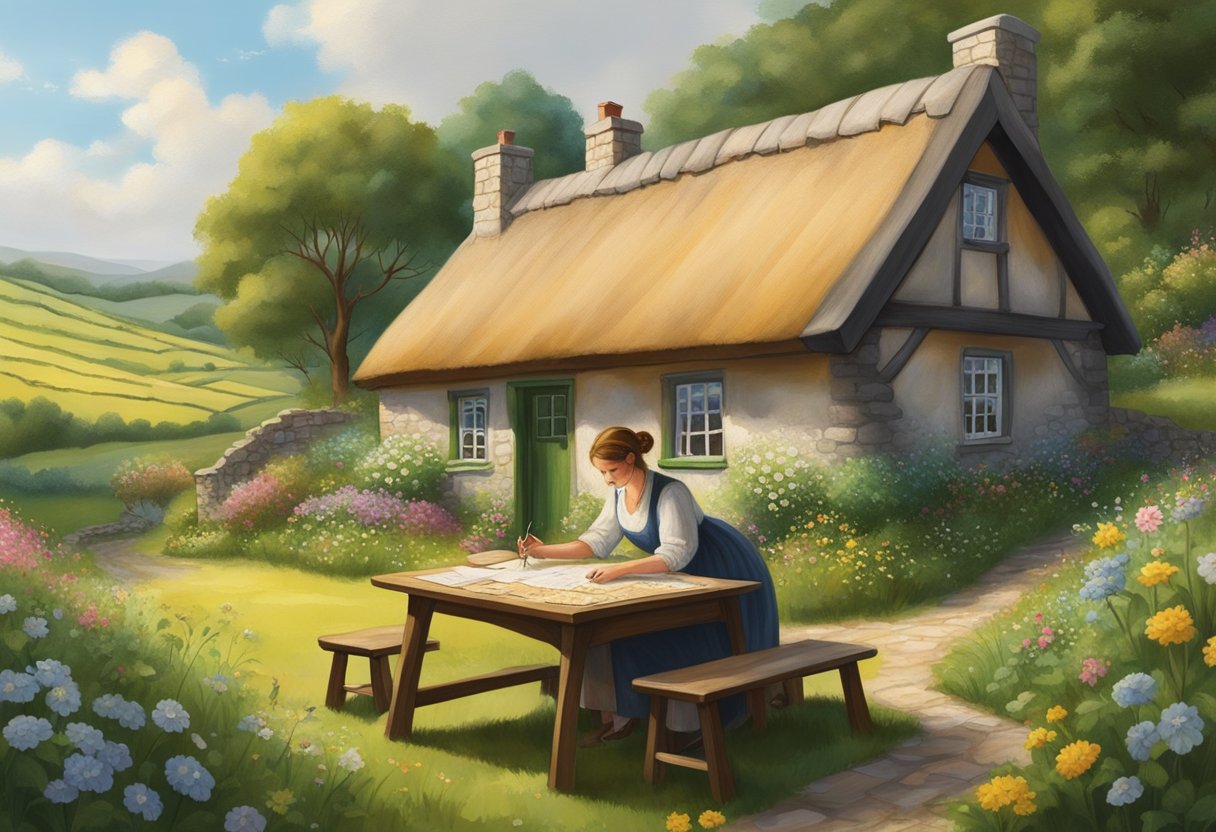
Ireland’s heritage in lace-making intertwines with the fabric of its history. During the 19th century, as the poverty-stricken nation faced the Great Famine, convents played a pivotal role in the inception of Irish crochet, teaching the art to women as a means of income. This skill, requiring simple tools such as bobbins and thread, blossomed into a cottage industry that provided financial support for families, especially in remote areas where employment was scarce.
The history of Irish crochet is fundamentally linked to convents and charitable institutions which sought to alleviate suffering through the promotion of this intricate craft. Derived from Venetian lace patterns, Irish lace built its uniqueness through the adaptation of its methods, developing a distinct style recognised for its ornate patterns and fine detail.
Notably, post-Famine lace-making was not confined to Ireland’s borders; it was influenced by continental designs, with France particularly notable for its contribution to the lace-making techniques that were eventually blended with Irish creativity. This Franco-Irish connection enhanced the craft’s complexity and appeal.
Women across Ireland contributed to the lace-making industry from their homes, nurturing a skill that not only filled the void of industrial employment but also preserved a piece of Irish culture that is admired to this day. As a part of our rich textile history, the tradition of making Irish crochet lace carries on, cherished for its beauty and its place in our cultural tapestry.
Irish Crochet Lace Basics
In this section, we are going to explore the fundamental aspects of Irish crochet lace, taking a closer look at its unique technique and how it stands out from other lace styles.
Understanding Crochet and Lace
Crochet is a process of creating fabric by interlocking loops of yarn, thread, or strands of other materials using a crochet hook. Lace, on the other hand, is a delicate fabric made of thread or yarn, characterised by open designs and patterns formed through various techniques, including crochet. Irish crochet lace combines these two elements, producing intricate lace patterns with a rich texture that is admired for both its beauty and craftsmanship.
Irish Crochet vs Other Lace Styles
Irish crochet is distinct from other types of lace. It often features layered and dimensional motifs, such as flowers and leaves, which are then connected with a mesh background. In contrast, bobbin lace employs a weaving technique using bobbins and a pillow, while needle lace involves needle and thread to stitch the lace by hand. Venetian lace, another famous style, is typically made using the needle lace method. Each style has its own historical and cultural significance, with Irish crochet known for its freeform and artistic expression, deeply rooted in Ireland’s lace-making tradition.
Essential Tools and Materials
Before embarking on the journey of Irish lace making, it’s vital to understand which tools and materials are indispensable. Ensuring you have the right equipment will smooth your path to creating intricate and delicate lace patterns that are characteristic of this traditional craft.
Choosing the Right Hook and Thread
In Irish crochet, the hook and thread are your primary tools. You’ll need a crochet hook that’s comfortable to hold and works well with fine threads. Sizes typically range from 1.75 mm to 1.25 mm, with smaller sizes used for finer work. Commonly used are sizes 10 and 20, with size 20 being notably finer than size 10.
As for the thread, it should be thin enough to allow for detailed work while being strong enough to hold the stitches well. Linen thread is a popular choice for its strength and delicacy, but cotton can also be used, especially in practice pieces. The thread should generally match the size of the hook, with smaller hooks necessitating finer thread.
Fabric and Linen Essentials
Most Irish lace projects are underpinned by a foundation fabric or linen onto which the crochet is worked. This linen often serves as a base to attach motifs and to provide structure. You’ll need a piece of fabric in a neutral tone that complements your thread colour. Additionally, a sturdy needle for basting your lace motifs onto the fabric is required.
It’s also important to have a variety of linens with different weaves, as the texture will affect the overall appearance of your finished lace. Strong and finely woven linen is the best choice for most projects, providing a stable base for your intricate patterns.
Mastering Fundamental Techniques
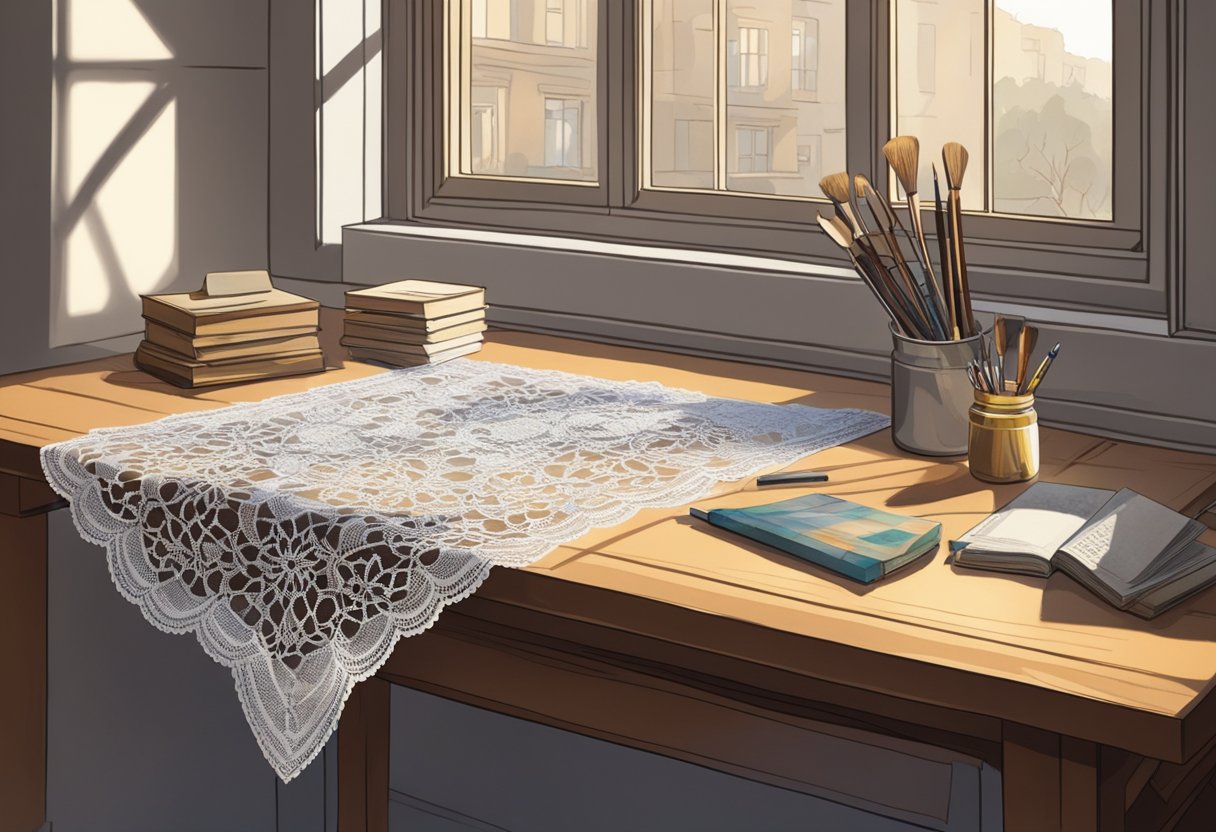
In sharpening our skills in Irish lace making, it’s crucial to build a strong foundation in both basic and advanced crochet techniques. Acquiring these skills will enable us to produce intricate designs characteristic of traditional and modern Irish crochet lace.
Basic Stitching Methods
We begin with basic stitching methods, which form the backbone of Irish crochet lace. These include chain stitch, slip stitch, and single crochet. Mastering these stitches is essential as they provide the framework for forming the net or mesh base that characterises this craft.
- Chain Stitch (ch): Creates the foundation of your crochet piece.
- Slip Stitch (sl st): Joins stitches and motifs with a minimal amount of height.
- Single Crochet (sc): Used extensively to create the dense, textured fabric.
We must also familiarise ourselves with working picots, small loops that give Irish crochet its signature delicate edging. Furthermore, handling bobbins efficiently is important, as they allow us to manage multiple threads while creating intricate patterns.
Advanced Crochet Techniques
Moving on to advanced crochet techniques, the focus shifts to creating elaborate motifs like flowers, leaves, and shamrocks that are unique to Irish crochet lace. Here are some critical techniques:
- Padding Cord: This gives structure and volume to our motifs.
- Clones Knot: For adding decorative, knotted embellishments to our lace.
Producing advanced motifs often requires us to work with delicate threads and may incorporate the use of fine hooks to achieve the exquisite details for which Irish crochet lace is renowned. Employing these techniques with precision allows us to create stunning, textural art pieces that echo the rich heritage of Irish craft.
Irish Lace Patterns and Motifs
Irish lace is renowned for its intricate designs and the use of delicate motifs. These elements are the essence of creating authentic Irish lace, embodying a rich heritage and exquisite craftsmanship.
Floral and Nature Elements
The hallmark of Irish lace is its celebration of the natural world, captured in the form of exquisite floral and nature elements. Motifs commonly depict an array of flowers, each meticulously crafted to showcase its unique beauty. Roses, shamrocks, and leaves are intricately represented, often surrounded by the traditional diamond mesh, which acts as a delicate lattice joining individual motifs. This mesh not only enhances the natural patterns but also gives the lace a structured yet airy quality.
- Flowers: Depictions of roses and other blossoms provide a romantic and timeless appeal.
- Leaves: Variations in leaf motifs offer a realistic touch, representing nature’s diversity.
- Shamrocks: A nod to Irish heritage, shamrock motifs interweave cultural significance with artistry.
Working with Lace Patterns
When creating Irish lace, attention to detail is paramount. Each piece, whether following established lace patterns or experimenting in freeform crochet, demands precision. For those starting their journey in lace-making, understanding pattern instructions is crucial, and mastering basic motifs is the first step towards constructing more elaborate designs.
- Begin with Basics: Start with simpler patterns such as individual flowers before progressing to more complex arrangements.
- Practice Diamond Mesh: Gain confidence in making the foundational mesh to connect your motifs seamlessly.
By familiarising ourselves with these patterns and motifs, we honour the timeless art of Irish lace-making, weaving together elements of elegance and tradition.
Constructing an Irish Lace Project
In this section, we guide you through the initial steps of starting your Irish lace project and then demonstrate how to piece individual elements together to create a beautiful, cohesive piece.
Starting Your Lace Project
Before we start making Irish crochet, we select a project that suits our skill level. For those new to the craft, online classes can be invaluable for learning the basic stitches and techniques. It’s essential to choose the right materials, including fine yarn, a suitable crochet hook, and if the design calls for it, beads and other embellishments. The style of Irish crochet lace we plan to make may vary from delicate, traditional patterns to more modern, freeform designs.
Piecing Elements Together
Once we have crafted the individual elements—which can range from simple flowers to intricate leaves—it’s time to bring our project to life by piecing them together. Our work often starts by crafting a fine mesh background on which we will strategically place and secure our elements. The placement can be influenced by traditional styles or our creative interpretation. Here are key steps to piece elements together:
- Lay Out Elements: Arrange your motifs on a flat surface to finalise their positions.
- Make the Mesh Ground: Create a mesh ground with chain stitches and single crochets as the base to attach your motifs.
- Attach Elements: Use slip stitches or fine sewing to secure each element onto the mesh.
- Finishing Touches: Add any final details, such as beads or additional embellishments.
This methodical approach enables us to build a project incrementally, ensuring each piece is crafted with precision and care, resulting in an exquisite piece of Irish crochet lace.
Irish Lace in Fashion and Design
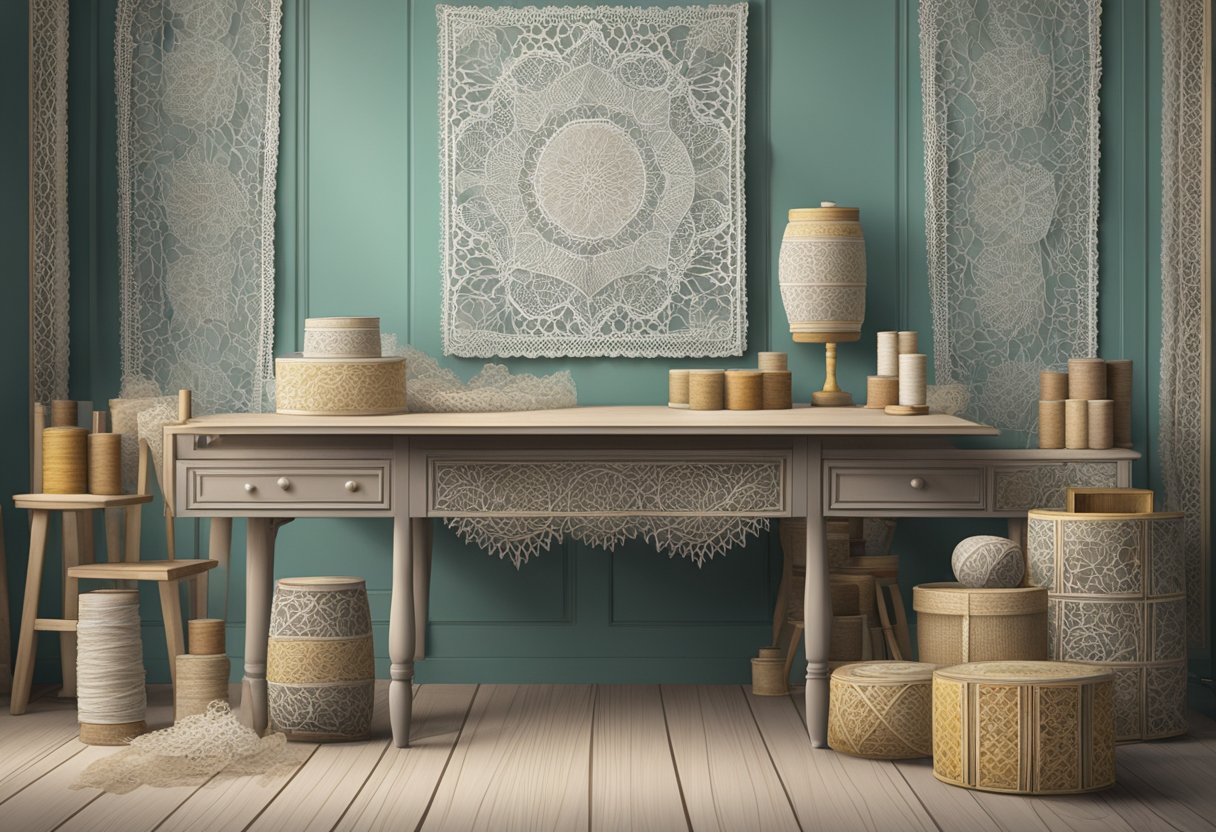
Irish lace has long been celebrated for its intricate patterns and exquisite detail, securing a coveted place in both historical and modern fashion circles. In this section, we explore its continued influence on contemporary clothing and decorative items.
Irish Lace in Contemporary Clothing
We often see Irish lace serving as an elegant touch on a variety of wearables, from high-end fashion to everyday apparel. The traditional craft is commonly incorporated into wedding dresses and christening robes, where it offers a timeless appeal. Designers have also adapted it to include collars on shirts and blouses, which can provide a sophisticated flair to casual wear. Versatile and delicate, Irish lace is a favourite among those who appreciate a fusion of classical and modern style.
Decorative Irish Lace Items
Beyond clothing, Irish lace is also a staple in home decor. It’s used to create ornamental pieces such as tablecloths, bedspreads, and pillowcases, enhancing the aesthetic of interiors with its handcrafted charm. Artisans may create wall hangings or frame lace designs as artwork, offering a nod to the detailed craftsmanship behind each hand-made piece. Despite the evolution of design trends, Irish lace maintains its status as a beloved decorative element for adding sophistication and elegance to the home.
Learning Venues and Resources
Irish lace making is a craft that combines beauty with intricacy. To help you start or advance your skills, we’ve compiled a list of venues and resources, focusing on schools, classes, and online patterns.
Schools and Classes for Irish Lace Making
-
The Guild of Irish Lacemakers: They often participate in workshops and demonstrations, such as the event held at Collins’ Barracks Museum in Dublin. These gatherings are excellent for hands-on learning under the guidance of experienced lacemakers. Learn more about their events.
-
Traditional Lace Makers of Ireland: They offer accommodation packages that include lace making classes in various styles, including Carrickmacross and Irish Crochet. Their expert teachers make learning accessible and enjoyable. Discover classes to attend.
-
Local Classes: Keep an eye out for classes in your area. Local craft stores and community colleges may offer sessions on traditional Irish lace crafts.
Finding Patterns and Projects Online
-
Roving Crafters: A great online resource to find free patterns and resources for making Irish Crochet Lace, ensuring you can practice and refine your lace making skills from the comfort of your home. Find patterns to try.
-
Online Craft Stores: Many online stores not only sell lace-making supplies but also provide patterns for various projects. Stores like these are invaluable for anyone looking to source materials or find new projects to work on.
Remember to utilise these venues and online resources to hone your craft. Whether you prefer a classroom setting or learning online, there are numerous options to help you master the art of Irish lace making.
Notable Irish Lace Types and Regions
Ireland’s rich textile tradition includes an array of distinctive laces, each bearing the name of its region of origin. These laces reflect the nuances of their locales with their unique styles and techniques.
Distinct Features of Clones Lace
Clones Lace originates from the town of Clones in County Monaghan. Characterised by its intricate patterns and use of fine cotton threads, Clones Lace often features bold floral motifs and a distinctive picot technique. These complex designs are crafted with a small crochet hook, creating a lace that is both beautiful and durable.
Exploring the Legacy of Limerick and Carrickmacross Lace
The Limerick Museum houses examples of Limerick Lace, a needlepoint lace distinct for its use of netting and patterns that are embroidered onto a mesh ground. Often, Limerick Lace integrates a combination of satin stitch and tambour work, which involves hooking through a fine net to create delicate patterns.
On the other hand, Carrickmacross Lace, hailing from the eponymous town in County Monaghan, employs a mix of lace appliqué and needlework. Its hallmark is the ‘poplin’ effect, achieved by applying fine muslin or cambric to a net backing, then adorning it with intricate embroidery. This style of lace became highly sought after, with discerning clients requesting it from regions such as Dublin and Galway, demonstrating its widespread appeal.
Preserving Irish Lace Heritage

Irish lace-making is a time-honoured craft that has been a part of Ireland’s cultural fabric for centuries. Efforts in preserving this delicate art form have focused on showcasing its historical importance through lace galleries, exhibitions, and dedicated Irish lace museums and collections.
Lace Galleries and Exhibitions
We find that lace galleries play a pivotal role in keeping the tradition of Irish lace alive. Galleries often host exhibitions featuring both historical and contemporary lace pieces, providing a platform for enthusiasts and newcomers alike to admire this intricate craft. The Headford Lace Project is a commendable example, diligently working to revive Headford’s lace heritage through various initiatives including exhibitions. Queen Victoria’s endorsement of Irish lace bolstered its popularity, making exhibitions that feature lace associated with her reign particularly captivating.
Irish Lace Museums and Collections
Our focus also extends to the lace museums dotted across Ireland which safeguard some of the most significant collections of handmade Irish lace. The Mountmellick Museum in Co Laois is one such establishment dedicated to the conservation of Mountmellick lace, a unique form of Irish needlework. Similarly, in towns like Carrickmacross and Limerick, which are synonymous with specific styles of Irish lace-making, we can find museums and permanent collections that pay homage to this art. They not only display exquisite lace pieces but also recount the stories of the transition from handmade to machine-made lace. The Limerick Museum further exemplifies this by presenting an array of historically significant lace items that depict the evolution of lace-making in Ireland.
Practical Tips for Lacemakers

When embarking on the journey of lacemaking, it’s essential to focus on quality from the get-go. Choose high-quality threads and tools, as they are foundational to the delicate nature of lace. Investing in good materials ensures that your creations stand the test of time and look their best.
Practice is indeed key to mastering lacemaking. We recommend setting aside regular time to hone your skills. Start with simpler stitches and patterns, gradually progressing to more intricate designs as your confidence grows.
In learning traditional styles like Tambour lace, it’s vital to maintain a steady hand and even tension. This style involves stretching the fabric over a hoop and using a fine hook to create a series of chain stitches, requiring concentration and a gentle touch.
For those interested in Kenmare lace, this Irish needlepoint technique is celebrated for its beauty and complexity. Patience is paramount, as is accuracy, to achieve the lace’s characteristic fine netting and bold motifs.
| Tip for Quality | Suggested Action |
|---|---|
| Thread Selection | Opt for linen or cotton threads known for durability. |
| Tool Maintenance | Keep your needles and bobbins smooth and free from burrs. |
Here are some actionable steps to enhance your lacemaking experience:
- Begin with smaller projects to avoid feeling overwhelmed.
- Work in a well-lit area to protect your eyes and ensure precision.
- Join a lacemaking group to connect with others and share techniques.
- Keep a scrapbook of patterns and samples for inspiration.
- Don’t be afraid to undo and redo; every mistake is a learning opportunity.
Remember, perfection takes time, so allow yourself to grow within the craft without rushing the process.
Frequently Asked Questions
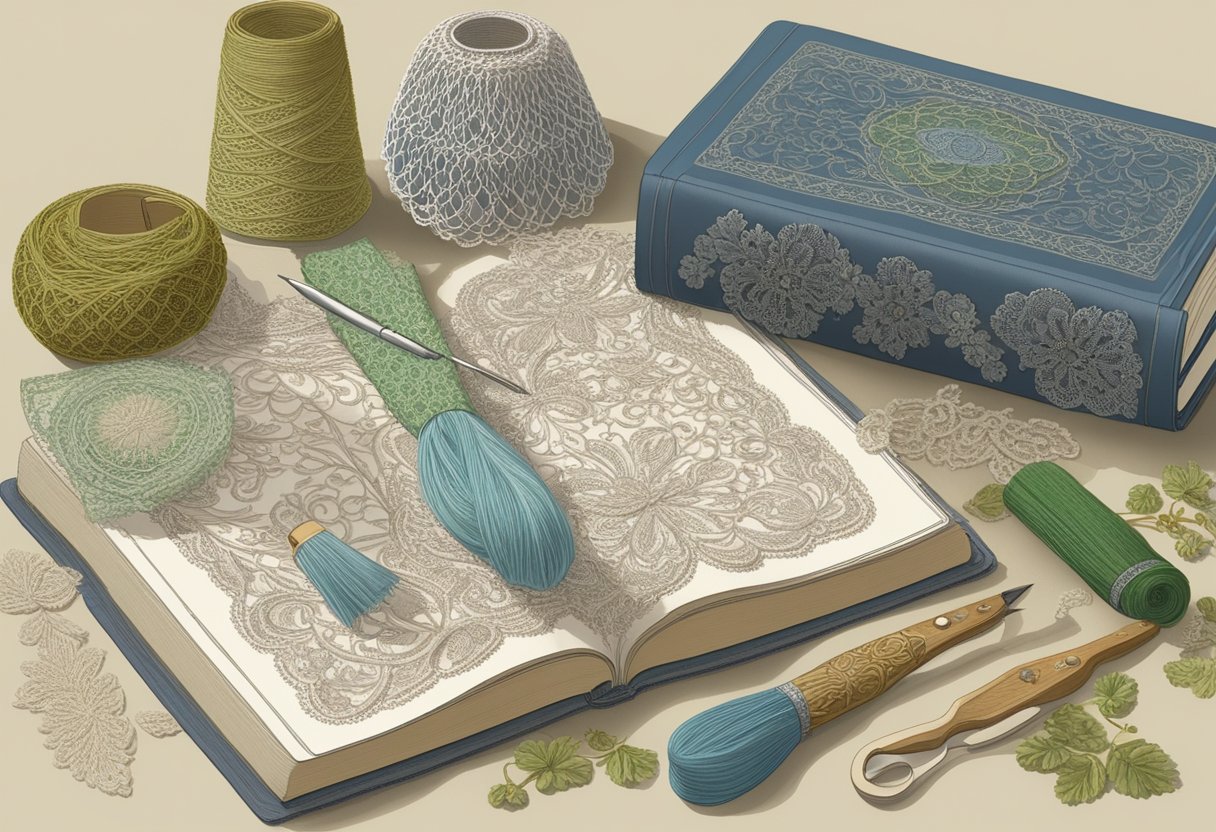
In this section, we’ll address some common inquiries about starting with Irish crochet lace, from selecting the right materials to finding the best learning resources.
Which type of yarn yields the best results in crochet lace making?
For crochet lace making, we generally recommend using fine cotton or linen thread. These materials create delicate and intricate patterns that are characteristic of traditional Irish crochet lace.
How does one begin learning Irish crochet lace as a beginner?
A beginner should start by practising basic crochet stitches with a smaller hook to achieve the tight and intricate stitches seen in Irish crochet lace. Starting with simple motifs, like shamrocks or roses, can help to build skill and confidence.
What are some reliable sources to find free patterns for Irish lace crochet?
You can find free patterns for Irish lace crochet from dedicated crochet communities like Roving Crafters and online archives such as the Antique Pattern Library.
Could you recommend some instructional books on Irish crochet lace?
We recommend books like “Masterpieces of Irish Crochet Lace: Techniques, Patterns, Instructions” which offer detailed instructions and historical context for learners interested in mastering Irish crochet lace.
Are there any PDF guides available for beginners to learn Irish lace making?
Indeed, there are numerous PDF guides available for beginners, such as those hosted by the Antique Pattern Library that can be downloaded at no cost.
What are the fundamental techniques to master when starting Irish lace crochet?
Mastering the fundamental stitches, such as the chain, slip stitch, single, double, and treble crochet, is essential. Additionally, one should learn to crochet motifs and lace grounds that tie the motifs together.






